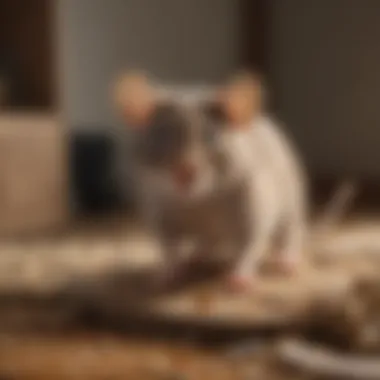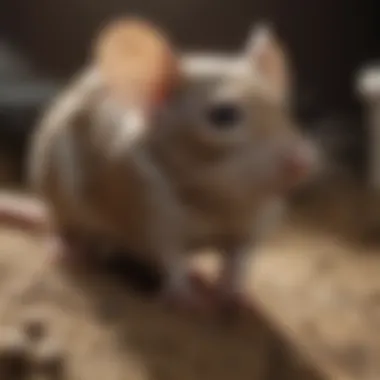Mice Control Techniques for Milwaukee Residents


Intro
Mice infestations pose a significant challenge for homeowners and renters in Milwaukee, affecting not only property but also health and comfort. Understanding how to manage these small rodents effectively requires an in-depth look at their behavior, signs of presence, and both preventive and treatment strategies. The urban environment contributes uniquely to these challenges. This article offers a detailed exploration of pest identification, prevention strategies, and treatment options tailored specifically for the Milwaukee area.
Pest Identification
Identifying the presence of mice is the first crucial step toward effective management. The house mouse and the deer mouse are among the most common species found in urban settings.
Detailed Descriptions of Common Pests
- House Mouse (Mus musculus): This small rodent typically has gray or brown fur, large ears, and a long tail. Adults usually measure between 2.5 to 4 inches in body length, excluding the tail. They are agile and can reproduce year-round, which amplifies their presence in residential areas.
- Deer Mouse (Peromyscus maniculatus): Often found in more rural or suburban parts, these mice are recognized by their bi-colored fur. Their bodies are light brown with a white underbelly and feet. They tend to avoid human contact, but may enter homes, especially when searching for food or nesting materials.
Signs and Symptoms of Infestations
Recognizing the signs of a mouse infestation is vital for timely intervention.
- Droppings: Small, dark droppings found near food sources or along walls can indicate mouse activity.
- Gnaw Marks: Mice gnaw on various materials such as wood, plastic, and even electrical wires. If you notice fresh gnaw marks, it's a clear sign of their presence.
- Nesting Materials: Mice use shredded paper, fabric, or insulation to build nests. Finding these materials in hidden areas can signal an infestation.
- Noises: Scratching sounds in walls or ceilings at night can indicate mice are moving about.
"Identifying the signs of a mice infestation early can prevent more extensive damage and health risks later on."
Prevention Strategies
Preventing a mice infestation involves proactive measures and regular home maintenance.
Home Maintenance Tips for Pest Prevention
- Seal Entry Points: Inspect the exterior of your home for any cracks or openings. Mice can squeeze through surprisingly small spaces. Use caulk or steel wool to fill gaps around windows, doors, and utility lines.
- Keep Food Secure: Store food in airtight containers. Ensure that pantry items are sealed tightly to deter mice from seeking easy food sources.
- Proper Waste Management: Keep trash bins covered and dispose of waste regularly, reducing the chance of attracting mice.
Natural Deterrents and Barriers
Utilizing natural deterrents can be effective in keeping mice away without chemical interventions.
- Peppermint Oil: The strong scent of peppermint may act as a repellent. Soaking cotton balls in peppermint oil and placing them in areas prone to infestations can help.
- Ultrasonic Repellents: These devices emit a high-frequency sound that can deter pests. Response to this strategy can vary, so it may not be universally effective.
Treatment Options
Should prevention efforts fail, it’s important to know the available treatment options.
Overview of Chemical vs. Natural Treatments
When addressing a mouse infestation, both chemical and natural treatments can be considered. Chemical options often include traps and poison. Natural alternatives include traps and various repellents. The choice of treatment may depend on the severity of the infestation and personal preferences regarding chemicals in the home.
Step-by-Step Guides for DIY Treatments
- Setting Traps: Use snap traps or glue boards, placing them in areas where mice are active. Always follow the manufacturer's instructions for effective results.
- Bait the Traps: Effective baits include peanut butter, chocolate, or oatmeal. Ensure that the bait is securely attached to the trap.
- Check Regularly: Inspect traps frequently to remove any caught mice and to reset them as needed.
- Dispose Safely: Follow local regulations for disposal. Ensure to wear gloves when handling traps to avoid contact with any pathogens.
Understanding the Mice Problem in Milwaukee


Understanding the issue of mice infestations in Milwaukee is crucial for effective management and control. Mice can cause considerable damage to property and pose health risks to humans. Their presence may indicate unsanitary conditions and can lead to further pest problems. This section aims to clarify the ecological and demographic factors that contribute to the mice problem in this urban setting.
Ecological Factors Contributing to Infestations
Milwaukee's geographical location plays a significant role in the prevalence of mice. The city has a mix of residential areas and natural environments, which provides ample hiding spots and nesting opportunities for mice. Rivers and parks, while appealing for outdoor activities, can also serve as habitats for mice. These ecological factors create a bridge between the city's human population and the natural, critter-filled surroundings.
Environmental conditions are also important. Warmer urban temperatures, especially during summer months, can encourage mice populations to thrive. They seek out shelter in homes and buildings, particularly during colder months. Additionally, the availability of food sources in urban areas, such as garbage, pet food, and compost, attracts these rodents. Therefore, recognizing these ecological aspects is key to understanding why mice are so prevalent in Milwaukee.
Demographic Trends and Mice Behavior
The demographic landscape of Milwaukee further influences the dynamics between humans and mice. Areas with high population density often see more interactions with pests. In many neighborhoods, housing structures are close together, which gives mice easy access to multiple homes. This scenario means an infestation in one place can quickly spread.
Furthermore, socio-economic factors can impact how residents manage pest issues. Lower-income households may lack access to effective pest control resources, leading to a greater likelihood of infestations. Understanding the behaviors of mice also is essential. They are nocturnal and tend to be skittish—often avoiding human encounters. These traits allow them to thrive undetected, making early identification critical for control efforts.
"The more you know about your environment, the better you can prepare against infestations. Awareness is the first step to prevention."
By examining ecological factors and demographic trends, homeowners can better position themselves to anticipate and manage mice infestations effectively. Knowing what attracts mice and the local context allows for more informed decision-making when it comes to prevention and control.
Identifying Mice in Your Home
Understanding how to identify mice in your home is crucial for effective pest management. Often, people ignore the early warning signs of an infestation, allowing the problem to escalate. Identifying these signs promptly can save homeowners significant time, costs, and potential damage. Moreover, recognizing the presence of mice aids in determining the right course of action for control and prevention.
Physical Signs of Infestation
When assessing your home for mouse activity, there are specific physical signs to bear in mind. Mice can be elusive, so their presence might not be immediately obvious. Here are some common indicators:
- Droppings: Tiny, dark pellets are often found in areas where mice frequent. The size and shape can vary but typically measure about a quarter of an inch.
- Gnaw marks: Look for small bite marks on furniture, walls, or packaging in your pantry. Mice need to gnaw to keep their teeth from growing too long.
- Nests: Mice build nests using shredded paper, fabric, or grass. Common nesting sites include hidden spots in attics or behind appliances.
- Scurrying noises: Listen for scratching or scurrying noises at night, a time when mice are most active.
"Early detection can prevent larger infestations and more significant damage to your home."
Common Locations for Mice Activity
Mice seek shelter in places that provide warmth and access to food. Knowing where to look is essential for effective identification. Some frequent areas include:
- Kitchens and Pantries: Mice are often drawn to food sources. Check behind cabinets and appliances, especially where crumbs might accumulate.
- Attics and Basements: These areas provide shelter. Inspect corners and hidden areas.
- Garages: Stored items can create nesting opportunities. Check inside boxes or bags.
- Pipes and Vents: Mice can travel through small openings, so inspect areas near plumbing and ventilation systems for signs of droppings or gnaw marks.
Identifying the signs of mice in your home is the initial step in keeping your living space pest-free. By observing these indications, you can take appropriate actions to mitigate further issues.
Preventive Measures for Mice Control
Preventive measures for mice control are crucial in managing infestations effectively. Understanding how to deter mice before they enter one’s home is essential. Proactive steps not only reduce the chances of an infestation but also save homeowners from the stress and costs associated with large-scale pest control treatments. Effective preventive strategies can lead to a more sustainable living environment, benefiting not just the household but the surrounding community as well.
Sealing Entry Points
Sealing entry points is one of the first steps in preventing mice from entering your home. Mice are small creatures, able to squeeze through holes as tiny as a dime. Therefore, identifying and sealing these gaps is foundational. Common areas to inspect include:
- Foundation cracks: Look for signs of wear around foundations.
- Windows and doors: Ensure they close tightly, and use weather stripping if necessary.
- Pipes and vents: Check where they enter the home for any gaps.
Using materials like steel wool or caulking can effectively block entry points. It is important to ensure that any gaps are filled using methods that mice cannot easily chew through. Investing time in this initial stage can save considerable trouble later on.


Reducing Attractants Inside the Home
Reducing attractants inside the home is a key preventive measure as it tackles the reasons why mice enter residences in the first place. Food and shelter are primary attractants for them. Here are effective ways to minimize these incentives:
- Proper food storage: Store food in sturdy containers, and keep pantries organized.
- Regular cleaning: Crumbs and spills can easily lure mice.
- Pet food management: Do not leave pet food out overnight.
- Garbage disposal: Ensure trash cans have tight-fitting lids and dispose of waste regularly.
In addition to food, creating an unwelcoming environment for nesting is vital. Regular decluttering helps eliminate potential hiding spots and nesting materials, enhancing the overall preparedness against mice invasions.
Best Practices for Outdoor Management
Outdoor management plays a significant role in creating an uninviting area for mice near one’s property. Here are some best practices:
- Landscape thoughtfully: Trim plants and shrubs, keeping them away from the house.
- Proper waste management: Secure trash containers outside to prevent access to food scraps.
- Maintain fences: Repair any holes in fences to discourage entry from wandering mice.
- Debris clearance: Remove old wood piles, fallen branches, and other debris from the yard, as these provide excellent nesting sites.
Incorporating these practices into daily routines can significantly reduce the possibility of mice infestations. Mice thrive in environments that offer easy access to food, water, and shelter, and taking steps to eliminate these resources is effective in control efforts.
"An ounce of prevention is worth a pound of cure."
By prioritizing preventive measures, homeowners can create a robust barrier against potential mice problems, ensuring a safer and cleaner environment.
Choosing Effective Control Solutions
Addressing a mouse infestation in Milwaukee requires careful consideration of various control solutions. This step is critical because the methods chosen can greatly affect the outcome of the pest management endeavor. Opting for suitable control solutions enables homeowners to combat the problem effectively and minimize future invasions.
In assessing control options, it is crucial to match the solution with the severity of the infestation. Each method carries its own set of benefits and drawbacks. Comprehensive understanding of these aspects can aid homeowners in making informed decisions. Furthermore, the implications on their immediate environment must also be considered. Choosing effective control solutions is not solely about eradication but also about long-term prevention and safety for all inhabitants of the home.
Natural Remedies for Mice Control
Natural remedies present an appealing alternative to traditional approaches for mice control. These methods are often less toxic and provide a level of safety for households with children and pets. Some popular natural deterrents include:
- Peppermint oil: Its strong scent can repel mice effectively. Placing cotton balls soaked in peppermint oil in areas where mice may enter can create a barrier.
- Ultrasonic repellents: These devices emit sounds at frequencies unpleasant to rodents. They can discourage mice from nesting in the vicinity.
- Trap and release methods: Live traps allow for capture without harming the animal, promoting ethical treatment of wildlife.
While these remedies can offer a degree of success, it is wise to combine them with other control strategies to ensure effectiveness. Regular checks and upkeep are crucial, as natural remedies may require consistent application to maintain deterrence.
Chemical Treatments and Their Efficacy
Chemical treatments remain a standard approach in pest management. They can provide swift results in eliminating an existing infestation. Different types of chemicals are utilized, including rodenticides and pheromone traps. Each has its unique application methods and levels of effectiveness.
It is important to approach chemical solutions with caution. Understand the specific products that are suitable for use within residential settings. The main considerations should include:
- Safety: Many chemical treatments can pose risks to children and pets.
- Target effectiveness: Select products that specifically target mice while being less harmful to other wildlife.
- Combination with preventive measures: Using chemical treatments alongside preventive practices often yields the best results.
A comprehensive understanding of the applied chemicals and their usage will enhance their effectiveness while addressing any potential hazards.
Professional Pest Control Services in Milwaukee
Engaging professional pest control services could serve as a viable solution for severe infestations. These experts possess knowledge, tools, and experience that a typical homeowner might lack. When seeking pest control services in Milwaukee, assessing the following factors is essential:


- Certifications and reputation: Look for companies with proven track records and proper certifications.
- Methods employed: Ensure that the pest control service uses effective and humane methods for removal and prevention.
- Follow-up services: Continuous monitoring and follow-up can assure long-term solutions.
Relying on professionals can save time and provide peace of mind, ensuring that the problem is effectively addressed. However, it is also critical to remain engaged in personal preventive practices, as this will support long-term pest management at home.
"The key to effective mice control is understanding that a blend of methods often leads to the best results."
By evaluating all these options, you can formulate a robust strategy to manage and eventually eliminate mice from your Milwaukee residence.
Aftermath of Mice Control
The aftermath of mice control is a critical phase in the overall process of management. It is not sufficient to merely remove the rodents; the effectiveness of the control measures must be evaluated. This section emphasizes what homeowners need to consider after taking action against mouse infestations in Milwaukee. Understanding the consequences and long-term implications of these methods ensures future problems are minimized and residents maintain a comfortable living environment.
Assessing the Success of Your Methods
Once a control program is implemented, it is important to assess whether it was successful. Homeowners should look for several signs:
- Reduced Activity: A significant drop in mouse sightings or droppings indicates success.
- Damage Repairs: Checking for new damages can help determine if the methods were effective or if new infestations have started.
- Trap Results: Regularly inspect traps and baits to track their effectiveness. Empty traps can suggest either good luck or the need for reassessment.
Documentation of findings is crucial. Keeping a log of what treatments were used and the results observed can help in future strategies. If success is not evident, it may be necessary to explore different methods or revisit preventive measures.
Long-Term Monitoring Strategies
Long-term monitoring is essential for maintaining a mice-free home. This involves establishing regular inspections and applying a proactive approach:
- Routine Checks: Inspect common areas such as basements, attics, and crawl spaces regularly to look for signs of mice or damage.
- Continued Preventive Measures: Persistent application of sealing entry points and removing attractants contributes to long-term success in mice control.
- Environmental Management: Evaluate the surroundings continually. The local environment can change and attract new mice if not monitored closely.
- Community Awareness: Engage with neighbors and local resources to stay alert for potential infestations in the area. Information sharing fosters a community effort against rodents.
Keeping a vigilant eye and practicing good housekeeping can deter future infestations effectively.
In summary, the aftermath of mice control is a pivotal aspect of successful management. Assessing the methods used and implementing long-term monitoring strategies can significantly prevent re-infestation. The emphasis should be on continual adaptability to evolving situations in Milwaukee's unique urban landscape.
Finale and Recommendations
In addressing the mice problem in Milwaukee, it is crucial to consolidate the insights gained throughout this article. The complexity of mice infestations demands a multi-faceted approach. Understanding the ecological and demographic factors provides context and highlights the need for tailored strategies.
The importance of summarizing key techniques cannot be understated. Effective mice management encompasses not only detection and prevention but also the implementation of appropriate control measures. This involves knowing how to seal entry points, manage attractants, and choose the right remedies, whether natural or chemical.
In addition to these strategies, homeowners and renters should be proactive in assessing their environment. Regular monitoring can lead to early detection of any potential issues. Understanding the typical signs of infestation and common active areas will enhance your effectiveness in managing mice.
Moreover, seeking professional assistance can significantly expedite the process when DIY methods are insufficient. Pest control services in Milwaukee bring expertise and tailored solutions.
"A proactive approach to mouse management is always the best defense."
By integrating these strategies, individuals can ensure a more comprehensive control plan that addresses both immediate concerns and long-term prevention. This proactive mindset is vital for maintaining a safe and healthy living environment.
Summary of Key Techniques
- Sealing Entry Points: Identify and eliminate small gaps or holes in walls, around pipes, and other potential entryways.
- Reducing Attractants: Participate in regular cleaning to minimize food sources and clutter that can attract mice.
- Effective Control Solutions: Evaluate the best remedies for your situation, balancing efficacy and safety.
- Outdoors and Landscaping: Optimize outdoor space to deter mice from gaining access to your home.
- Long-Term Monitoring: Commit to periodic checks to ensure ongoing effectiveness of control measures.
Final Thoughts on Mice Control in Milwaukee
Controlling mice in Milwaukee is not just about immediate action; it is also about long-term strategies and education. The urban landscape can create unique challenges, thus requiring constant adaptation and vigilance. Homeowners should not wait for signs of infestation to act. Instead, they can apply learned techniques as preventative measures.
For more details, visit resources like Wikipedia or Britannica. Relevant discussions may also be found on platforms like Reddit or Facebook.
Engagement in community forums can enhance understanding and foster collaboration in best practices for pest control.



